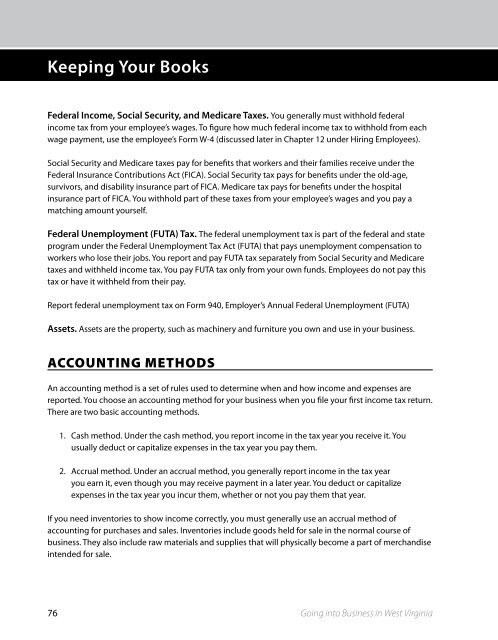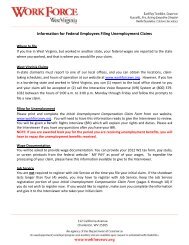Going Into Business in West Virginia - West Virginia Department of ...
Going Into Business in West Virginia - West Virginia Department of ...
Going Into Business in West Virginia - West Virginia Department of ...
Create successful ePaper yourself
Turn your PDF publications into a flip-book with our unique Google optimized e-Paper software.
Keep<strong>in</strong>g Your Books<br />
Federal Income, Social Security, and Medicare Taxes. You generally must withhold federal<br />
<strong>in</strong>come tax from your employee’s wages. To figure how much federal <strong>in</strong>come tax to withhold from each<br />
wage payment, use the employee’s Form W-4 (discussed later <strong>in</strong> Chapter 12 under Hir<strong>in</strong>g Employees).<br />
Social Security and Medicare taxes pay for benefits that workers and their families receive under the<br />
Federal Insurance Contributions Act (FICA). Social Security tax pays for benefits under the old-age,<br />
survivors, and disability <strong>in</strong>surance part <strong>of</strong> FICA. Medicare tax pays for benefits under the hospital<br />
<strong>in</strong>surance part <strong>of</strong> FICA. You withhold part <strong>of</strong> these taxes from your employee’s wages and you pay a<br />
match<strong>in</strong>g amount yourself.<br />
Federal Unemployment (FUTA) Tax. The federal unemployment tax is part <strong>of</strong> the federal and state<br />
program under the Federal Unemployment Tax Act (FUTA) that pays unemployment compensation to<br />
workers who lose their jobs. You report and pay FUTA tax separately from Social Security and Medicare<br />
taxes and withheld <strong>in</strong>come tax. You pay FUTA tax only from your own funds. Employees do not pay this<br />
tax or have it withheld from their pay.<br />
Report federal unemployment tax on Form 940, Employer’s Annual Federal Unemployment (FUTA)<br />
Assets. Assets are the property, such as mach<strong>in</strong>ery and furniture you own and use <strong>in</strong> your bus<strong>in</strong>ess.<br />
Account<strong>in</strong>g Methods<br />
An account<strong>in</strong>g method is a set <strong>of</strong> rules used to determ<strong>in</strong>e when and how <strong>in</strong>come and expenses are<br />
reported. You choose an account<strong>in</strong>g method for your bus<strong>in</strong>ess when you file your first <strong>in</strong>come tax return.<br />
There are two basic account<strong>in</strong>g methods.<br />
1. Cash method. Under the cash method, you report <strong>in</strong>come <strong>in</strong> the tax year you receive it. You<br />
usually deduct or capitalize expenses <strong>in</strong> the tax year you pay them.<br />
2. Accrual method. Under an accrual method, you generally report <strong>in</strong>come <strong>in</strong> the tax year<br />
you earn it, even though you may receive payment <strong>in</strong> a later year. You deduct or capitalize<br />
expenses <strong>in</strong> the tax year you <strong>in</strong>cur them, whether or not you pay them that year.<br />
If you need <strong>in</strong>ventories to show <strong>in</strong>come correctly, you must generally use an accrual method <strong>of</strong><br />
account<strong>in</strong>g for purchases and sales. Inventories <strong>in</strong>clude goods held for sale <strong>in</strong> the normal course <strong>of</strong><br />
bus<strong>in</strong>ess. They also <strong>in</strong>clude raw materials and supplies that will physically become a part <strong>of</strong> merchandise<br />
<strong>in</strong>tended for sale.<br />
76<br />
<strong>Go<strong>in</strong>g</strong> <strong>in</strong>to <strong>Bus<strong>in</strong>ess</strong> <strong>in</strong> <strong>West</strong> Virg<strong>in</strong>ia

















